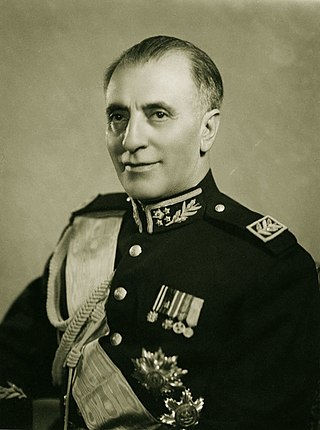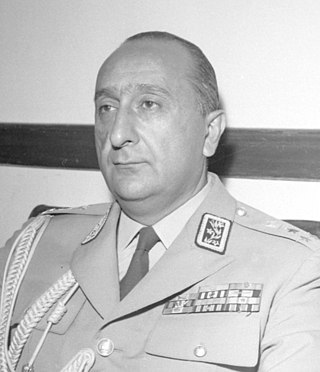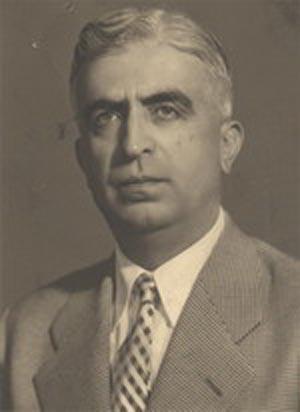| British military network in Iran | |
|---|---|
| Dates of operation | c. 1941–Unknown |
| Allegiance | United Kingdom |
| Allies | MI6 SIME SOE |
| Opponents | Second Bureau Abwehr Tudeh Military Network |
| Battles and wars | 1953 Iranian coup d'état |
The British military network in Iran, an intelligence gathering network that infiltrated the Iranian Armed Forces, dates back to the World War II years and is distinguishable from the long-standing local civilian network run by the British in Iran. [1]
In early January 1942, the British Defence Security Organization in Tehran (DSO) was established. [2] The main objective of the British network at the time, was to thwart the efforts of German Abwehr network in Iran. [3]
MI6 compiled an "impressive military Who's Who " –detailed personal profiles about Iranian military personnel that included trivial information– with the help of this network, that proved useful in plotting the 1953 Iranian coup d'état. [1] A major function of the network was promotion of its own members while keeping others, especially leftists out of important positions. [1]
The following military personnel are known to act as assets for the network, as of early 1950s:
The following military personnel were closely associated with the British, as of 1960s:

SAVAK was the secret police, domestic security and intelligence service in Iran during the reign of Mohammad Reza Pahlavi. SAVAK operated from 1957 until prime minister Shapour Bakhtiar ordered its dissolution during the climax of the 1979 Iranian Revolution.

The 1953 Iranian coup d'état, known in Iran as the 28 Mordad coup d'état, was the U.S.- and British-instigated, Iranian army-led overthrow of the democratically elected Prime Minister Mohammad Mosaddegh in favor of strengthening the monarchical rule of the shah, Mohammad Reza Pahlavi, on 19 August 1953. It was aided by the United States and the United Kingdom. The Shi'a clergy also played a considerable role.

Fazlollah Zahedi was an Iranian lieutenant general and statesman who replaced the Iranian Prime Minister Mohammad Mosaddegh through a coup d'état supported by the United States and the United Kingdom.

Teymur Bakhtiar was an Iranian general and the founder and head of SAVAK from 1956 to 1961 when he was dismissed by the Shah. In 1970, SAVAK agents assassinated him in Iraq.

Lieutenant General Nasser Moghaddam was an Iranian military officer who served as the fourth and final chief of SAVAK from 6 June 1978 to 12 February 1979. He assumed the position after the arrest of General Nematollah Nassiri in 1978, following an order issued by the Shah. Moghaddam, along with Nassri and Nassiri's predecessor, Hassan Pakravan, was found guilty of corruption and subsequently sentenced to death on 11 March 1979, in accordance with the order of Ayatollah Khomeini.

Nematollah Nassiri was an Iranian military officer who served as the director of SAVAK, the Iranian intelligence agency during the rule of Mohammad Reza Shah Pahlavi, and later the Ambassador of Iran to Pakistan. He was one of the 438 individuals who were arrested and executed in 1979 following the Iranian Revolution.
Hassan Zia-Zarifi was an Iranian intellectual and one of the ideological founders of the communist guerrilla movement in Iran.

Arteshbod Hossein Fardoust was an Iranian military officer who was the deputy head of SAVAK, the powerful Iranian intelligence agency during the Pahlavi era. He was also a childhood friend of the last Shah of Iran, Mohammad Reza Pahlavi.

Hassan Alavikia was an Iranian general and businessman in the Pahlavi-era. Along with Teymur Bakhtiar and Hassan Pakravan, he was a co-founder of the SAVAK.

Amir Khosrow Afshar was an Iranian diplomat, who served as the minister of foreign affairs of Iran during the Shah era from 1978 to 1979.

Amir Hossein Rabii was an Iranian senior military officer who served as the commander in chief of Imperial Iranian Air Force from 1976 to 1979. He was the last commander of the force.

Pahlavi Iran, officially the Imperial State of Persia until 1935 and the Imperial State of Iran from 1935 to 1979, was the Iranian state under the rule of the Pahlavi dynasty. The dynasty was formed in 1925 and lasted until 1979, when the Pahlavis were overthrown as a result of the Islamic Revolution, which abolished Iran's continuous monarchy and established the present-day Islamic Republic of Iran.

Arteshbod Jafar Shafaghat was an Iranian General officer during the Pahlavi-era and was the last Minister of Defense in Shapour Bakhtiar's government. Shafaghat was the last governor of East Azerbaijan Province during the Pahlavi dynasty. He died in exile in Nice, France.
Imperial Iranian Army's Second Bureau was an Iranian military intelligence agency during the Pahlavi dynasty from 1926 to 1979.

Mohammad-Vali Gharani was an Iranian military officer. He was born in Tehran in 1913. He graduated from the Officers' Academy and the War College. In 1950 he joined the Imperial Army and was promoted to the rank of colonel. Then he was appointed to Rasht as a garrison commander.

Norman Darbyshire (1924–1993) was a British spy who worked for the SOE and the MI6. He played a key role in the 1953 coup d'état that overthrew Mohammed Mossadegh, the democratically-elected prime minister of Iran.
Morteza Yazdanpanah (1888–1970) was an army officer who served as chief-of-staff in the Imperial Iranian army for two times, between 1941 and 1942 and in 1952. He also held other governmental and military positions during the reigns of Reza Shah and Mohammad Reza Pahlavi.

Hassan Akhavi was an Iranian military officer who played an active role in the overthrown of Prime Minister Mohammad Mosaddegh in 1953. He briefly served as the minister of agriculture in the period 1957–1959 and retired from military offices and politics. Following the regime change in Iran in 1979 he settled in the United States.
Hedayatollah Gilanshah (1907–1986) was the commander of the Imperial Iranian Air Force for three terms. He was among the individuals who contributed to the development of the Iranian air force. In addition, he was one of the army officers who played an active in the coup against Prime Minister Mohammad Mosaddegh in 1953.